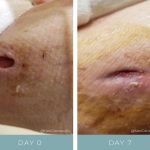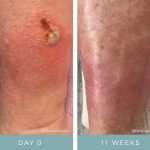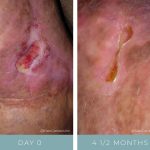Diabetic Ulcers
 Diabetic foot ulcers are a major complication of diabetes mellitus. A foot ulcer is an open sore or wound that occurs in approximately 15 percent of patients with diabetes and is commonly located on the bottom of the foot. Of those who develop a foot ulcer, 6 percent will be hospitalized due to infection or other ulcer-related complication. Diabetes is the leading cause of non-traumatic lower extremity amputations, and approximately 14-24 percent of patients with diabetes who develop a foot ulcer will require an amputation. Foot ulceration precedes 85 percent of diabetes-related amputations.
Diabetic foot ulcers are a major complication of diabetes mellitus. A foot ulcer is an open sore or wound that occurs in approximately 15 percent of patients with diabetes and is commonly located on the bottom of the foot. Of those who develop a foot ulcer, 6 percent will be hospitalized due to infection or other ulcer-related complication. Diabetes is the leading cause of non-traumatic lower extremity amputations, and approximately 14-24 percent of patients with diabetes who develop a foot ulcer will require an amputation. Foot ulceration precedes 85 percent of diabetes-related amputations.
Wound healing is an innate mechanism of action that works reliably most of the time. A key feature of wound healing is the repair of lost extracellular matrix (ECM) that forms the largest component of the dermal skin layer. But in some cases, certain disorders or physiological insult disturbs the wound healing process. Diabetes mellitus is a metabolic disorder that impedes the normal steps of the wound healing process. Many studies show a prolonged inflammatory phase in diabetic wounds, which affects tissue repair, causing a delay in the formation of new tissue.
Prevention and Treatment
As serious as a diabetic foot ulcer is, research has shown that development of a foot ulcer is preventable. The old thought of “let the air get at it” is now known to be harmful to healing. We know that wounds and ulcers heal faster, with a lower risk of infection, if they are kept covered and moist. The use of full-strength betadine, hydrogen peroxide, whirlpools, and soaking are not recommended, as these practices could lead to further complications.
When diabetic foot ulcers do occur, treatment should include: blood sugar control, removing dead tissue from the wound, dressings, and removing pressure from the wound through techniques such as total contact casting. Surgery in some cases may improve outcomes. Hyperbaric oxygen therapy may also help heal the diabetic ulcer.
NeoGenesis Recovery Serum for Diabetic Ulcers
Along with the other treatments prescribed and recommended by your health care provider, NeoGenesis Recovery, abundant in S²RM®, is a natural and effective treatment that is very helpful in giving the wound the molecules it needs to support healing. Twice daily topical application, or application of Recovery when the dressing is changed, can help support the healing process.
Brochures:
Reviews:
 “I met with my client Larry again today and he is absolutely thrilled with the healing that has taken place since he started using the Recovery Serum (about 30 days ago). Larry is a diabetic with extremely poor circulation. He has been coming to me weekly and we have had to work around 4 major open wounds. I only have gotten pics the last 2 weeks of the ones on his right shin. This was a result of a vascular procedure to restore blood flow to his leg and foot. Here are pics of the 2 wounds on his shin, pics on the left were from 7/15/21, right is from today 7/22/21. Unbelievable difference in ONE week.” ~ Tracy Lacina – Skin Deep Salon & Spa
“I met with my client Larry again today and he is absolutely thrilled with the healing that has taken place since he started using the Recovery Serum (about 30 days ago). Larry is a diabetic with extremely poor circulation. He has been coming to me weekly and we have had to work around 4 major open wounds. I only have gotten pics the last 2 weeks of the ones on his right shin. This was a result of a vascular procedure to restore blood flow to his leg and foot. Here are pics of the 2 wounds on his shin, pics on the left were from 7/15/21, right is from today 7/22/21. Unbelievable difference in ONE week.” ~ Tracy Lacina – Skin Deep Salon & Spa
Product: NeoGenesis Recovery
 “We started using Recovery and saw improvement in his leg, noticeable improvement, not just in the healing but also in the color. In less than 8 weeks the big ulcer had healed. The feel of his leg and the discomfort in his legs had disappeared and he now has no pain. They are now looking healthy, feeling healthier, and the open sores have totally healed. It’s life changing.” ~ MJ
“We started using Recovery and saw improvement in his leg, noticeable improvement, not just in the healing but also in the color. In less than 8 weeks the big ulcer had healed. The feel of his leg and the discomfort in his legs had disappeared and he now has no pain. They are now looking healthy, feeling healthier, and the open sores have totally healed. It’s life changing.” ~ MJ
Product: NeoGenesis Recovery
 “I’ve been battling with an open wound on my leg now for approximately 10 years, on and off. It has not been easy, my foot and ankle constantly hurt… My friend raved so much about NeoGenesis, I knew I was going to have to try the product … very pleased that I did. I’ve already seen the progress Recovery has made on my leg in less than a month. It is amazing what Recovery has done for the texture, color and itchiness of the scar area around the wound.” ~ CW
“I’ve been battling with an open wound on my leg now for approximately 10 years, on and off. It has not been easy, my foot and ankle constantly hurt… My friend raved so much about NeoGenesis, I knew I was going to have to try the product … very pleased that I did. I’ve already seen the progress Recovery has made on my leg in less than a month. It is amazing what Recovery has done for the texture, color and itchiness of the scar area around the wound.” ~ CW
Product: NeoGenesis Recovery

